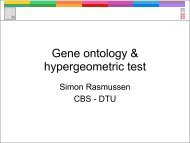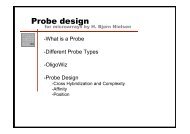Computational tools and Interoperability in Comparative ... - CBS
Computational tools and Interoperability in Comparative ... - CBS
Computational tools and Interoperability in Comparative ... - CBS
You also want an ePaper? Increase the reach of your titles
YUMPU automatically turns print PDFs into web optimized ePapers that Google loves.
3100–3108 Nucleic Acids Research, 2007, Vol. 35, No. 9 Published onl<strong>in</strong>e 22 April 2007<br />
doi:10.1093/nar/gkm160<br />
RNAmmer: consistent <strong>and</strong> rapid annotation<br />
of ribosomal RNA genes<br />
Kar<strong>in</strong> Lagesen 1,2, *, Peter Hall<strong>in</strong> 3 , E<strong>in</strong>ar Andreas Rødl<strong>and</strong> 1,2,4,5 , Hans-Henrik Stærfeldt 3 ,<br />
Torbjørn Rognes 1,2,4 <strong>and</strong> David W. Ussery 1,2,3<br />
1 Centre for Molecular Biology <strong>and</strong> Neuroscience <strong>and</strong> Institute of Medical Microbiology, University of Oslo,<br />
NO-0027 Oslo, Norway, 2 Centre for Molecular Biology <strong>and</strong> Neuroscience <strong>and</strong> Institute of Medical Microbiology,<br />
Rikshospitalet-Radiumhospitalet Medical Centre, NO-0027 Oslo, Norway, 3 Center for Biological Sequence<br />
Analysis, Biocentrum-DTU, Technical University of Denmark, DK-2800 Lyngby, Denmark, 4 Department of<br />
Informatics, University of Oslo, PO Box 1080 Bl<strong>in</strong>dern, NO-0316 Oslo, Norway <strong>and</strong> 5 Norwegian Comput<strong>in</strong>g<br />
Center, PO Box 114 Bl<strong>in</strong>dern, NO-0314 Oslo, Norway<br />
Received December 1, 2006; Revised <strong>and</strong> Accepted March 2, 2007<br />
ABSTRACT<br />
The publication of a complete genome sequence is<br />
usually accompanied by annotations of its genes.<br />
In contrast to prote<strong>in</strong> cod<strong>in</strong>g genes, genes for<br />
ribosomal RNA (rRNA) are often poorly or <strong>in</strong>consistently<br />
annotated. This makes comparative<br />
studies based on rRNA genes difficult. We have<br />
therefore created computational predictors for the<br />
major rRNA species from all k<strong>in</strong>gdoms of life <strong>and</strong><br />
compiled them <strong>in</strong>to a program called RNAmmer.<br />
The program uses hidden Markov models tra<strong>in</strong>ed on<br />
data from the 5S ribosomal RNA database <strong>and</strong><br />
the European ribosomal RNA database project.<br />
A pre-screen<strong>in</strong>g step makes the method fast with<br />
little loss of sensitivity, enabl<strong>in</strong>g the analysis of<br />
a complete bacterial genome <strong>in</strong> less than a m<strong>in</strong>ute.<br />
Results from runn<strong>in</strong>g RNAmmer on a large set of<br />
genomes <strong>in</strong>dicate that the location of rRNAs can be<br />
predicted with a very high level of accuracy. Novel,<br />
unannotated rRNAs are also predicted <strong>in</strong> many<br />
genomes. The software as well as the genome<br />
analysis results are available at the <strong>CBS</strong> web server.<br />
INTRODUCTION<br />
Ribosomes are the molecular mach<strong>in</strong>es which form the<br />
connection between nucleic acids <strong>and</strong> prote<strong>in</strong>s <strong>in</strong> all liv<strong>in</strong>g<br />
organisms. The ribosome’s dependence on ribosomal<br />
RNAs (rRNAs) for its function has caused them to be<br />
conserved at both the sequence <strong>and</strong> the structure level.<br />
Because of this, rRNAs are often used <strong>in</strong> comparative<br />
studies such as phylogenetic <strong>in</strong>ference. <strong>Comparative</strong><br />
studies have become more popular as more genomes<br />
have been completely sequenced, but can potentially<br />
*To whom correspondence should be addressed. Tel: þ4722844786; Email: kar<strong>in</strong>.lagesen@medis<strong>in</strong>.uio.no<br />
become complicated when some of the genes they are<br />
based on are poorly annotated or not annotated at all.<br />
Unfortunately, this is often a problem with rRNAs as<br />
genome annotation pipel<strong>in</strong>es usually do not <strong>in</strong>clude <strong>tools</strong><br />
specific for rRNA detection. Instead, rRNAs are often<br />
located by sequence similarity searches such as BLAST.<br />
Although such searches may give reasonable answers due<br />
to the high level of sequence conservation <strong>in</strong> the core<br />
regions of the genes, us<strong>in</strong>g such results for annotation<br />
purposes can be problematic. The validity of the search<br />
results depends on the program <strong>and</strong> database used.<br />
Chang<strong>in</strong>g one or both of these can drastically change<br />
the results. Genomic databases have grown exponentially<br />
over the past two decades <strong>and</strong> search programs have as a<br />
consequence had to undergo constant revisions <strong>in</strong> order to<br />
meet the requirements of the research community. Thus,<br />
the results of a search done today are probably very<br />
different from those produced several years ago. An added<br />
complication is that the most commonly used database<br />
search methods have poor performance for noncod<strong>in</strong>g<br />
RNAs. A recent study compar<strong>in</strong>g several different<br />
methods for predict<strong>in</strong>g noncod<strong>in</strong>g RNAs, <strong>in</strong>clud<strong>in</strong>g<br />
rRNAs, found that the most commonly used methods<br />
gave the most <strong>in</strong>accurate results (1).<br />
Through our work on the GenomeAtlas database (2),<br />
we have seen the results of poor annotation of rRNAs.<br />
Some genomes do not have any rRNAs annotated at all,<br />
whereas other genomes seem to have rRNAs annotated<br />
on the wrong str<strong>and</strong>. We <strong>in</strong>itially tried to do systematic<br />
BLAST (3) searches, but it proved difficult to ma<strong>in</strong>ta<strong>in</strong><br />
consistency throughout this process. The high level of<br />
sequence conservation among the rRNAs enabled us to<br />
create hidden Markov models (HMMs) from structural<br />
alignments. Such models are more capable of captur<strong>in</strong>g<br />
the sequence variation that is <strong>in</strong>herently present <strong>in</strong><br />
the rRNA gene families than simple BLAST searches.<br />
ß 2007 The Author(s)<br />
This is an Open Access article distributed under the terms of the Creative Commons Attribution Non-Commercial License (http://creativecommons.org/licenses/<br />
by-nc/2.0/uk/) which permits unrestricted non-commercial use, distribution, <strong>and</strong> reproduction <strong>in</strong> any medium, provided the orig<strong>in</strong>al work is properly cited.









